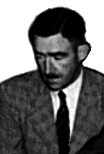





James Stanley Rogers was born in Tasmania, and studied at the University of Melbourne. He was a Senior Lecturer in Physics at the University when the Second World War began, and it was through his connection with T.H. Laby that he became the Secretary of the Optical Munitions Panel. In this capacity, Rogers took the minutes of every Panel meeting:
Dr Rogers' minutes I think should be historically preserved because they were beautifully and promptly done. Within a day or two of every meeting there were Rogers' minutes.- Sir Lawrence Hartnett (1)
Rogers was an active participant in the work of the Panel and, in 1941, he suggested to A.L. McAulay, a Panel member and Head of the Physics Department at the University of Tasmania, that he might like to try to make roof prisms. This suggestion marked the start of a successful optics project in Hobart, involving a combination of science and industry (see Waterworth).
In his capacity as a Panel member and physicist, Rogers also visited the USA in 1943, where he saw first-hand the large-scale production of optical glass and instrument components. (Shown here: J.S. Rogers (L) and E.O. Hercus (R))
At the final meeting of the Panel in November 1945, it was agreed that Rogers would write a history of the Panel and arrange for its printing through the Directorate of Ordnance Production. This he did, and many historians are indebted to him for his accurate and thorough record-keeping. (See J.S. Rogers, The History of the Optical Munitions Panel: July 1940 - December 1946, Australian Archives, Brighton, Melbourne, MP 730/11, Box 3.)
After the war, Rogers continued to work at the University of Melbourne as Warden of its Mildura Branch, then as Dean of Graduate Studies, 1950-1963. Rogers was made an Honorary Fellow of the Australian Institute of Physics in 1964.
(1) Sir Laurence Hartnett (1985), 'Recollections of the Optical Munitions Panel in Australia', Australian Physicist, vol. 22, May, pp. 158-60; with notes by H.C. Bolton, p. 159.








 Top |
Bright SPARCS |
ASAPWeb
Top |
Bright SPARCS |
ASAPWeb
